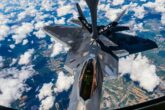November 10, 2021
Sharper: Global Posture
Analysis from CNAS experts on the most critical challenges in U.S. foreign policy.
The Department of Defense is finalizing the first global posture review of the Biden administration, an assessment of the U.S. military's global footprint. What will the administration’s key priorities be as the United States scales back its posture in the Middle East and transitions to a growing presence in the Indo-Pacific? CNAS experts are sharpening the conversation about the future of U.S. military posture and readiness under the Biden administration. Continue reading this edition of Sharper to explore their ideas and recommendations.
Features
When Less Is More: Rethinking U.S. Military Strategy and Posture in the Middle East
Successive U.S. presidents have tried to pivot to the Indo-Pacific and reduce forces in the Middle East, but time and again they have been drawn back in by crises that are partially triggered by rapid U.S. withdrawals from the region. To avoid continuing this cycle, a new CNAS report by authors Becca Wasser, Ilan Goldenberg, Elisa Catalano Ewers, and Lilly Blumenthal proposes a significant revision of the current U.S. military footprint in the region that meaningfully reduces U.S. presence while still protecting key U.S. interests.
Risky Business: Future Strategy and Force Options for the Defense Department
Despite the overarching strategic priorities laid out by the Biden administration and initial indicators provided by the Department of Defense, it is unclear how the next National Defense Strategy will prioritize threats and assign the primary role of the U.S. military. In a CNAS report, Stacie L. Pettyjohn, Becca Wasser, and Jennie Matuschak examine three possible strategy and force structure options for the Biden administration under a flat budget that prepare for posture resiliency. Using tabletop exercises and budgetary analysis, they assess whether these options can sufficiently meet the challenges of daily competition and future great-power conflict, and ensure America’s long-term military technological edge.
What the New China Focus Gets Wrong
"In the rush to address the neglect, however, Washington risks making a different blunder: subsuming all U.S. foreign policy to the U.S.-Chinese rivalry," writes CNAS CEO Richard Fontaine. "Already, in several parts of the world, troops have been withdrawn, regional diplomacy redefined, and U.S. intelligence assets redirected, all in the name of a more robust posture toward China. But the United States is a global power, not a regional one, and China is hardly the only problem it faces. Nor do enduring American interests outside the Indo-Pacific flow merely from the growing competition with China. It is necessary for Washington to prioritize China without allowing that focus to harm other interests and priorities. Balance, rather than tilting too far in one direction, should be the watchword."
When Less Is More
For the past 20 years, the U.S. military has invested heavily in the Middle East. Presidents Barack Obama and Donald Trump both attempted to shift assets out of the region and...
Risky Business: Future Strategy and Force Options for the Defense Department
To consider the next defense strategy and the tradeoffs associated with different options, we developed three possible strategies—high-end deterrence, day-to-day competition, ...
What the New China Focus Gets Wrong
It is necessary for Washington to prioritize China without allowing that focus to harm other interests and priorities. Balance, rather than tilting too far in one direction, s...
Special Event
Russia: An Assumptions Check
As part of the CNAS 2021 National Security Conference, CNAS experts hosted an interactive virtual session to check key assumptions about Russia, the challenges it poses, and how the United States can respond. How should U.S. policymakers think about the Russia challenge, especially in the face of other national security priorities? From the SolarWinds cyber breach to Moscow’s massive military buildup on Ukraine’s border this spring, Russia’s enduring threat to U.S. security interests is clear. CNAS Senior Fellow and Director of the Transatlantic Security Program Andrea Kendall-Taylor moderated a conversation featuring Eddie Fishman, Michael Kofman, and Margarita Konaev.
Commentaries
The Myth of Russian Decline: Why Moscow Will Be a Persistent Power
"The problem is that the case for Russian decline is overstated. Much of the evidence for it, such as Russia’s shrinking population and its resource-dependent economy, is not as consequential for the Kremlin as many in Washington assume," argue Andrea Kendall-Taylor and Michael Kofman in Foreign Affairs. "Nor should the United States expect that Russia will automatically abandon its course of confrontation once President Vladimir Putin leaves office. Putin’s foreign policy enjoys widespread support among the country’s ruling elite, and his legacy will include a thicket of unresolved disputes, chief among them that over the annexation of Crimea. Any disagreements with the United States are here to stay."
All About Access: Solving America’s Force Posture Puzzle
"The posture review currently underway has major implications for U.S. grand strategy," write Becca Wasser and Renanah M. Joyce in The Washington Quarterly. "Forward presence has historically served three fundamental objectives: to deter adversaries from dominating regions of vital interest to the United States; to bolster U.S. ability to defend its interests and allies; and to reassure allies that the United States is, in fact, committed to their defense. These objectives remain relevant today, but current forms of posture are increasingly vulnerable to physical contestation as great-power adversaries enhance their military capabilities and operational concepts. Moreover, states hosting U.S. forces and bases are also vulnerable to political and economic coercion, which could have implications for U.S. posture. Future efforts must therefore focus on achieving a resilient, combat-credible force posture. But as previous administrations have sought to make changes to relatively stagnant U.S. global posture and failed, what could make the Biden administration’s attempt to revise posture successful?"
The Myth of Russian Decline: Why Moscow Will Be a Persistent Power
Rather than viewing Russia as a declining power, U.S. leaders should see it as a persistent one—and have a frank conversation about the country’s true capabilities and vulnera...
All About Access: Solving America’s Force Posture Puzzle
This impulse to remake the US global footprint reflects a desire to address a new era of strategic competition with China and to expend finite resources and taxpayer dollars m...
The U.S. Army’s New Iron Triangle: The Coming Budget Crunch and Its Implications for Modernization
"It would be prudent for Futures Command and the Army to make those choices based on a rigorous prioritization between competing challenges," writes Billy Fabian in Defense News. "The resulting trade-offs among modernization efforts will certainly incur risk somewhere, but the far riskier path is not prioritizing in the face of significant cuts because failing to do so could result in a force that is unprepared to meet any challenges. Moreover, the Army should open the aperture beyond just modernization and use this prioritization to drive all its choices — on doctrine, readiness, posture and especially end strength. In short, the Army must think hard about exactly what kind of Army it needs to be in a more budget-constrained world. The answer to this question will do much to guide how it addresses this new iron triangle when the budget ax comes."
Making the U.S. Military’s Counter-Terrorism Mission Sustainable
"A comprehensive framework for assigning counter-terrorism missions is critical for avoiding the extremes of path dependency on the one hand and overcorrection or a disjointed transition on the other hand," observed Stephen Tankel in War on the Rocks. "It would also provide a mechanism for recalibrating counter-terrorism-related force structure and posture requirements as terrorist threats and Defense Department priorities evolve. Finally, such a framework could also help the Pentagon evaluate the counter-terrorism-related infrastructure that it has developed since 9/11: authorities and execute orders, policy shops, and military task forces, including the role of the theater special operations commands under the geographic combatant commands."
The US Army’s new iron triangle: The coming budget crunch and its implications for modernization
Each side of the iron triangle comes with its own implications for doctrine, force structure, readiness, posture and modernization....
Making the U.S. Military’s Counter-Terrorism Mission Sustainable
Focusing on interstate strategic competition requires investing the mental energy necessary to develop a more sustainable approach to counter-terrorism....
In the News
Featuring commentary and analysis by Lisa Curtis, Katherine Kuzminski, Stacie Pettyjohn, Becca Wasser, and Duyeon Kim.
In Afghan Withdrawal, a Biden Doctrine Surfaces
In the chaotic finale of America’s 20-year war in Afghanistan, a Biden Doctrine is emerging: a foreign policy that avoids the aggressive tactics of forever wars and nation bui...
Navy's Century-Old SWO Career Path Needs Big Changes, Government Watchdog Says
The federal government's watchdog agency is recommending that the Navy make significant changes to the Surface Warfare Officer, or SWO, career path. The Government Accountabil...
If China Is the No. 1 Threat, Why Doesn’t the 2022 Budget Reflect It?
For the last decade, combatant commanders for the Middle East and Asia-Pacific have found themselves competing for warships, aircraft, and surveillance assets. Decisions often...
Why Joe Biden is ending America’s combat mission in Iraq
When the first American bombs began falling on Iraq on March 19th 2003, President George W. Bush predicted a hard slog. “A campaign on the harsh terrain of a nation as large a...
South Korea to Biden administration: North Korea is ‘strengthening’ its missile program
South Korean Foreign Minister Chung Eui-yong is calling on the U.S. government to detail more specific incentives it might offer North Korea in face-to-face negotiations, warn...
Thank you for registering! You will receive a confirmation email shortly. All CNAS events are free, open to the public, and viewable from cnas.org/live.
Stay up-to-date with report releases, events, major updates, and announcements from the Center for a New American Security.
More from CNAS
-
America Must Salvage Its Relationship With India
The longer the current crisis lasts, the harder it will be to restore the relationship and the more likely it is that the two countries will lose an entire generation of progr...
By Richard Fontaine & Lisa Curtis
-
Defense & Aerospace Air Power Podcast: Global View
In a week when airpower news came from every angle, Becca Wasser, CNAS adjunct senior fellow, was on top of it all. She leads defense research at Bloomberg Economics, and we c...
By Becca Wasser
-
Indo-Pacific Security / Technology & National Security
AI and Policy, Both Foreign and DomesticIn an episode recorded just before Christmas, Darren interviews Janet Egan, Senior Fellow and Deputy Director of the Technology and National Security Program at CNAS, about AI...
By Janet Egan
-
25% Tariff Threat Torments Tehran: What Will Be Trump’s Next Step? Experts Weigh In
In this episode of Newstrack, Maria Shakeel examines the escalating crisis in Iran as the nation faces its deadliest wave of unrest in decades. Citizens are protesting soaring...
By Lisa Curtis
















